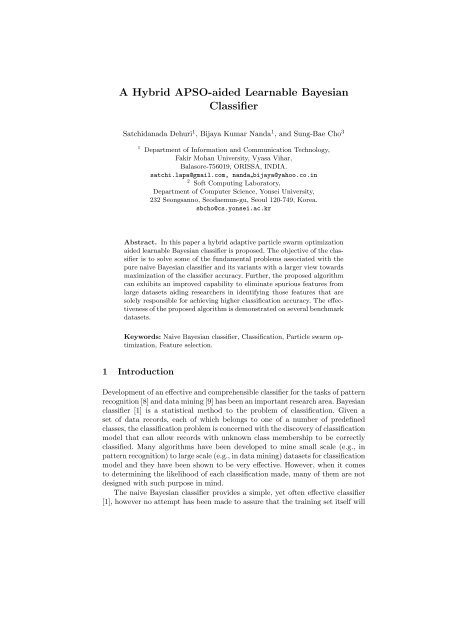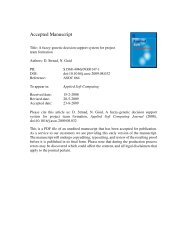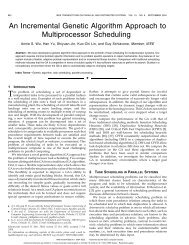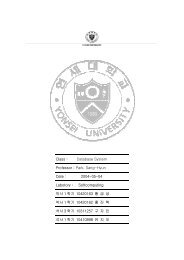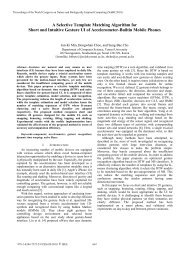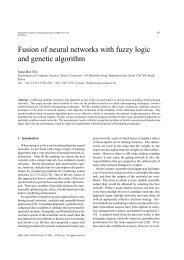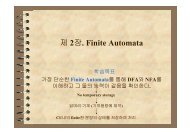A Hybrid APSO-aided Learnable Bayesian Classifier
A Hybrid APSO-aided Learnable Bayesian Classifier
A Hybrid APSO-aided Learnable Bayesian Classifier
You also want an ePaper? Increase the reach of your titles
YUMPU automatically turns print PDFs into web optimized ePapers that Google loves.
A <strong>Hybrid</strong> <strong>APSO</strong>-<strong>aided</strong> <strong>Learnable</strong> <strong>Bayesian</strong><br />
<strong>Classifier</strong><br />
Satchidanada Dehuri 1 , Bijaya Kumar Nanda 1 , and Sung-Bae Cho 3<br />
1 Department of Information and Communication Technology,<br />
Fakir Mohan University, Vyasa Vihar,<br />
Balasore-756019, ORISSA, INDIA.<br />
satchi.lapa@gmail.com, nanda bijaya@yahoo.co.in<br />
2 Soft Computing Laboratory,<br />
Department of Computer Science, Yonsei University,<br />
232 Seongsanno, Seodaemun-gu, Seoul 120-749, Korea.<br />
sbcho@cs.yonsei.ac.kr<br />
Abstract. In this paper a hybrid adaptive particle swarm optimization<br />
<strong>aided</strong> learnable <strong>Bayesian</strong> classifier is proposed. The objective of the classifier<br />
is to solve some of the fundamental problems associated with the<br />
pure naive <strong>Bayesian</strong> classifier and its variants with a larger view towards<br />
maximization of the classifier accuracy. Further, the proposed algorithm<br />
can exhibits an improved capability to eliminate spurious features from<br />
large datasets aiding researchers in identifying those features that are<br />
solely responsible for achieving higher classification accuracy. The effectiveness<br />
of the proposed algorithm is demonstrated on several benchmark<br />
datasets.<br />
Keywords: Naive <strong>Bayesian</strong> classifier, Classification, Particle swarm optimization,<br />
Feature selection.<br />
1 Introduction<br />
Development of an effective and comprehensible classifier for the tasks of pattern<br />
recognition [8] and data mining [9] has been an important research area. <strong>Bayesian</strong><br />
classifier [1] is a statistical method to the problem of classification. Given a<br />
set of data records, each of which belongs to one of a number of predefined<br />
classes, the classification problem is concerned with the discovery of classification<br />
model that can allow records with unknown class membership to be correctly<br />
classified. Many algorithms have been developed to mine small scale (e.g., in<br />
pattern recognition) to large scale (e.g., in data mining) datasets for classification<br />
model and they have been shown to be very effective. However, when it comes<br />
to determining the likelihood of each classification made, many of them are not<br />
designed with such purpose in mind.<br />
The naive <strong>Bayesian</strong> classifier provides a simple, yet often effective classifier<br />
[1], however no attempt has been made to assure that the training set itself will
e correctly classified, the training set is just used to determine the probabilities.<br />
Yagar [7] suggest an approach to learning the weights based on teaching the<br />
model using orderd weighted aggregated (OWA) approach, but the main problem<br />
is that the weights are very sensitive to local optima. Therefore, to reduce<br />
the local optima problem this paper suggest a hybrid adaptive particle swarm<br />
optimization (H<strong>APSO</strong>) which is relatively less explored and comparatively new<br />
problem solving domian in statistical classifier for learning the weights.<br />
Existing classifier such as Naive <strong>Bayesian</strong>, extended <strong>Bayesian</strong>, knn[15], backpropagation<br />
neural network [13], decision tree based algorithms [16](e.g., BOAT],<br />
C4.5, PUBLIC, Rain- Forest, SLIQ, SPRINT) can be used to uncover classification<br />
model for classifying records with unknown class membership. But a higher<br />
number of dimensions always put bounds in achieving desired accuracy. Feature<br />
selection, which aims to reduce the number of features (dimensions), is a<br />
well-known problem and is usually regarded as a technique to improve the classification<br />
algorithm. The reduction of feature space can lead to benefits in terms<br />
of accuracy and simplicity. Furthermore, identifying the features that have no<br />
need to be collected and stored always brings much financial saving [17]. For<br />
these reasons, feature selection is usually merged into the process of establishing<br />
a classification model. The present method is used to solve classification problem<br />
and can simultaneously identify the important features.<br />
In a nutshell, the contribution of the paper is to design a hybrid adaptive PSO<br />
for learning the extended <strong>Bayesian</strong> classifier with a simultaneous optimization<br />
of feature subset and classification accuracy.<br />
The organization of the paper is as detailed. Section 2 describes the preliminary<br />
concepts as used in proposed method. Section 3 describes the hybrid<br />
adaptive PSO and learning algorithm for the extended <strong>Bayesian</strong> classifier. The<br />
effectiveness of the classifier based on empirical study is described in Section 4.<br />
Conclusions are presented in Section 6.<br />
2 Preliminaries<br />
2.1 Naive <strong>Bayesian</strong> <strong>Classifier</strong><br />
Consider the task of assigning a sample to one of k classes, {C1, C2, C3, ...., Ck},<br />
based on the n-dimensional observed feature vector −→ x . Let p( −→ x |Ci) be the probability<br />
density function for the feature vector, −→ x , when the true class of the sample<br />
is Ci. Also, let P (Ci) be the relative frequency of occurrence class Ci in<br />
the samples. If no feature information is available, the probability that a new<br />
sample will be of class Ci is P (Ci)this probability is referred to as the a priori or<br />
prior probability. Once the feature values are obtained, we can combine the prior<br />
probability with the class-conditional probability for the feature vector, p( −→ x |Ci),<br />
to obtain the posteriori probability that a pattern belongs to a particular class.<br />
This combination is done using Bayes theory.<br />
P (Ci| −→ x ) =<br />
p( −→ x |Ci)P (Ci)<br />
k<br />
j=1 p(−→ x |Cj)P (Cj)<br />
(1)
Once the posterior probability is obtained for each class, classification is a<br />
simple matter of assigning the pattern to the class with the highest posterior<br />
probability. The resulting decision rule is Bayes decision rule:<br />
given −→ x , decide Ci if P (Ci| −→ x ) > P (Cj| −→ x ) ∀j<br />
When the class-conditional probability density for the feature vector and the<br />
prior probabilities for each class are known, the Bayes classifier can be shown to<br />
be optimal in the sense that no other decision rule will yield a lower error rate.<br />
Of course, these probability distributions (both a priori and a posteriori) are<br />
rarely known during classifier design, and must instead be estimated from training<br />
data. Class-conditional probabilities for the feature values can be estimated<br />
from the training data using either a parametric or a non-parametric approach.<br />
A parametric method assumes that the feature values follow a particular probability<br />
distribution for each class and estimate the parameters for the distribution<br />
from the training data. For example, a common parametric method first assumes<br />
a Gaussian distribution of the feature values, and then estimates the parameters<br />
µi and σi for each class, Ci, from the training data. A non-parametric approach<br />
usually involves construction of a histogram from the training data to approximate<br />
the class-conditional distribution of the feature values.<br />
x 2 + y 2 = z 2<br />
Once the distribution of the feature values has been approximated for each<br />
class, the question remains how to combine the individual class-conditional probability<br />
density functions for each feature, p(x1|Ci), p(x2|Ci), ..., p(xd|Ci) to determine<br />
the probability density function for the entire feature vector: p( −→ x |Ci).<br />
A common method is to assume that the feature values are statistically independent:<br />
p( −→ x |Ci) = p(x1|Ci) × p(x2|Ci) × ... × p(xn|Ci) (3)<br />
The resulting classifier, often called the naive Bayes classifier, has been shown to<br />
perform well on a variety of data sets, even when the independence assumption<br />
is not strictly satisfied [8]. The selection of the prior probabilities for the various<br />
categories has been the subject of a substantial body of literature [9]. One of<br />
the most common methods is to simply estimate the relative frequency for each<br />
class from the training data and use these values for the prior probabilities. An<br />
alternate method is to simply assume equal prior probabilities for all categories<br />
by setting P (Ci) = 1<br />
k , i = 1, 2, ...., k.<br />
The naive <strong>Bayesian</strong> classifier is summerized using the following computational<br />
procedure.<br />
– <strong>Classifier</strong> Construction<br />
1. Determine the probabilities, P (Cj) using the training data.<br />
2. Use training data to determine the category means and variances for<br />
continuous variables and category conditional probabilities for discrete<br />
variable.<br />
– Classification of Unknown Sample, −→ x<br />
1. Calculate p(x|Ci)P (Ci) for each Ci.<br />
2. Assign −→ x to the category attaining the largest score.<br />
(2)
2.2 Particle Swarm Optimization<br />
Particle swarm optimization technique is considered as one of the modern heuristic<br />
algorithm for optimization introduced by James Kennedy and Eberhart in<br />
1995 [5]. A swarm consists of a set of particles moving around the search space,<br />
each representing a potential solution (fitness). Each particle has a position<br />
vector (xi(t)), a velocity vector (vi(t)), the position at which the best fitness<br />
(pbesti) encountered by the particle, and the index of the best particle (gbest)<br />
in the swarm. Moreover, each particle knows the best value so far in the group<br />
(gbest) among pbests. Each particle tries to modify its position using the following<br />
information along with their previous velocity:<br />
1. The distance between the current position and pbest,<br />
2. The distance between the current position and gbest.<br />
In each generation, the velocity of each particle is updated to their best<br />
encountered position and the best position encountered by any particle using<br />
equation (3).<br />
vi(t) = vi(t − 1) + c1 ∗ r1(t) ∗ (pbesti − xi(t)) + c2 ∗ r2(t) ∗ (gbest − xi(t)) (4)<br />
The parameters c1 and c2 are called acceleration coefficients, namely cognitive<br />
and social parameter, respectively. r1(t) and r2(t) are random values, uniformly<br />
distributed between zero and one and the value of r1(t) and r2(t) is not same for<br />
every iteration. The position of each particle is updated every generation. This<br />
is done by adding the velocity vector to the position vector, as given in equation<br />
(4).<br />
xi(t) = xi(t − 1) + vi(t) (5)<br />
However, in the first version of PSO, there was no actual control over the<br />
previous velocity of the particles. In the later versions of PSO, this shortcoming<br />
was addressed by incorporating two new parameters, called inertia weight<br />
introduced by Shi and Ebherhart [10] and constriction factor (χ) introduced by<br />
Clerc and Kennedy [18] addressed in equation (5) and (6) respectively.<br />
vi(t) = w ∗ vi(t − 1) + c1 ∗ r1(t) ∗ (pbesti − xi(t)) + c2 ∗ r2(t) ∗ (gbest − xi(t)), (6)<br />
where w is called the inertia weight.<br />
vi(t) = χ{vi(t − 1) + c1 ∗ r1(t) ∗ (pbesti − xi(t)) + c2 ∗ r2(t) ∗ (gbest − xi(t))} (7)<br />
2<br />
χ =<br />
|2 − c − √ c2 , (8)<br />
− 4c|
where c = c1 + c2, c > 4.<br />
Shi and Eberhart [10] have found a significant improvement in the performance<br />
of PSO with the linearly decreasing inertia weight over the generations,<br />
time-varying inertia weight (TVIW) which is given in equation (8).<br />
w = w2 + (<br />
maxiter − iter<br />
) ∗ (w1 − w2), (9)<br />
maxiter<br />
where w1 and w2 are the higher and lower inertia weight values and the values of<br />
w will decrease from w1 to w2. iter is the current iteration (or generation) and<br />
maxiter is the maximum number of iteration (or total number of generation).<br />
Then, Ratnaweera and Halgamuge [12] introduced a time varying acceleration<br />
co-efficient (TVAC), which reduces the cognitive component, c1 and increases the<br />
social component, c2 of acceleration co-efficient with time. With a large value of<br />
c1 and a small value of c2 at the beginning, particles are allowed to move around<br />
the search space, instead of moving toward pbest. A small value of c1 and a large<br />
value of c2 allow the particles converge to the global optima in the latter part<br />
of the optimization. The TVAC is given in equations (9) and (10).<br />
c1 = (c1i − c1f ) ∗ (<br />
c2 = (c2i − c2f ) ∗ (<br />
maxiter − iter<br />
) + c1f<br />
maxiter<br />
maxiter − iter<br />
) + c2f<br />
maxiter<br />
(10)<br />
(11)<br />
where c1i and c2i are the initial values of the acceleration coefficient c1 and<br />
c2 and c1f and c2f are the final values of the acceleration co-efficient c1 and c2,<br />
respectively.<br />
Thus far we have discussed PSO for continuous space, however, many optimization<br />
problems including the problem to be solved in this paper are set in a<br />
space featuring discrete, qualitative distinctions between variables and between<br />
levels of variables.<br />
3 H<strong>APSO</strong> for <strong>Learnable</strong> <strong>Bayesian</strong> <strong>Classifier</strong><br />
3.1 Adaptive PSO<br />
In the standard PSO method, the inertia weight is made constant for all the<br />
particles in a single simulation, but the most important parameter that moves<br />
the current position towards the optimum position is the inertia weight (w). In<br />
order to increase the search ability, the algorithm should be redefined in a manner<br />
that the movement of the swarm should be controlled by the objective function.<br />
In adaptive PSO [6], the particle position is adjusted such that the highly fitted<br />
particle (best particle) moves slowly when compared to the less fitted particle.<br />
This can be achieved by selecting different w values for each particle according<br />
to their rank, between wmin and wmax as in the following form:
wi = wmin + wmax − wmin<br />
× ranki. (12)<br />
T pop<br />
where T pop is denoted as size of the swarm. From equation (11), it can be seen<br />
that the best particle assigned with first takes the inertia weight of minimum<br />
value while that for the lowest fitted particle takes the maximum inertia weight,<br />
which makes that particle move with a high velocity.<br />
The velocity of each particle is updated using equation (3), and if any updated<br />
velocity goes beyond Vmax, it is limited to Vmax using equation (12).<br />
vij(t) = sign(vij(t − 1)) ∗ min(|vij(t − 1)|, Vjmax). (13)<br />
The new particle position is obtained by using equation (8), and if any particle<br />
position goes beyond the range specified, it is adjusted to its boundary using<br />
equation (13) and (14)<br />
xij(t) = min(xij(t), rangejmax), (14)<br />
xij(t) = max(xij(t), rangejmin), (15)<br />
Furthermore the concept of re-initialization in <strong>APSO</strong> algorithm is introduced<br />
to escape the algorithm from premature convergence to a local optimum and<br />
further improvement is not noticeable.<br />
3.2 <strong>Hybrid</strong> <strong>APSO</strong><br />
Most of the applications have been concentrated on solving continuous optimization<br />
problems. However, in this research the problem space is defined as the<br />
combination of continuous and discrete optimization. In addition to invention<br />
of PSO for continuous search space, Kennedy and Eberhart [4] also developed<br />
a binary version of PSO for discrete optimization problems. The discrete PSO<br />
essentially differs from the original (or continuous) PSO in two characteristics.<br />
First the particle is composed of the binary variable. Second the velocity represents<br />
the probability of bit xij taking the value 1. In otherwords if vij = 0.3, then<br />
there is a 30% chance that xij will be a 1, and a seventy percent chance it will<br />
be zero. Since the velocity vector contains all the probabilistic values, therefore<br />
it must be constrained to the ineterval [0.0, 1.0].<br />
In this research, we combined the best effort of adaptive PSO (<strong>APSO</strong>) and<br />
binary PSO (BPSO)to explore the continuous and discrete search space simultaneously.<br />
Like PSO, <strong>APSO</strong> is initialized with a group of random particles (solutions)<br />
from continuous and discrete domain and then searches for optima by<br />
updating each iteration. In every iteration, each particle is updated by following<br />
two best values. The first one is the local best solution a particle has obtained<br />
so far. This value is called personal best solutions. Another, best value is that<br />
the whole swarm has obtained so far. This value is called global best solution.
The representation of the <strong>Bayesian</strong> coefficients (discussed in Subsection 3.3)<br />
on the particle is fairly direct- a real value from [0, 1]. In order to infer the<br />
minimal set of features required for accurate classification, it is desirable to<br />
promote parsimony in the discriminant function- that is, as many coefficients<br />
should be reduced to zero (specifically n th and (n − 1) th coefficients) as possible<br />
without sacrificing classification accuracy. While the cost function encourages<br />
parsimony by penalizing a coefficient vector for each non-zero value, a simple<br />
real valued representation for the coefficients themselves does not provide an<br />
easy means for the <strong>APSO</strong> to reduce coefficients to zero. Several method were<br />
tested to aid the search for a minimal feature set, including reducing weight vales<br />
below a predefined threshold value to zero, and including a penalty term in the<br />
cost function for higher weight values. the method that proved most effective,<br />
however, was a hybrid representation that incorporates both the ideas like PSO<br />
for continuous domain (<strong>APSO</strong>) and PSO for discrete domain i.e., called binary<br />
PSO. In this representation, a mask field is associated with each coefficients. The<br />
contents of the mask field determine whether the coefficient is included in the<br />
classifier or not. A single bit mask is assigned to each coefficients. The particle<br />
representation is given below.<br />
Coefficients(Real Values) w1 w2 w3 w4<br />
Mask (0/1) m1 m2 m3 m4<br />
If the value of mi, i = 1(1)5 is 1, then the coefficient is weighted and included<br />
in the classifier. If on the other hand, the mask bit for a coefficient was set to 0,<br />
then the weight was treated effectively as zero, eliminating the coefficient from<br />
consideration by the classifier.<br />
In a nutshell, the particle swarm formula:<br />
−→ v i(t) = −→ v i(t − 1) + c1 ⊗ r1 ⊗ ( −−−→<br />
pbest i − −→ x i(t)) + c2 ⊗ r2 ⊗ ( −−−→<br />
gbest − −→ x i(t)), (16)<br />
remains unchanged. The position of each particle is changed by the following<br />
rule:<br />
The coefficient vector is changed like standard PSO, where as the mask vector<br />
is changed like BPSO. However, the velocity of each particle contains the<br />
probability, must be constrained to the interval [0, 1]. A logistic transformation<br />
S(vij) can be used to change the mask vector of each particle.<br />
if (rand() < s(vij))<br />
xij = 1;<br />
else<br />
xij = 0;<br />
where the function s(.) is a sigmoidal limiting transformation and rand() is a<br />
quasirandom number selected from a uniform distribution in [0, 1].
3.3 <strong>Learnable</strong> <strong>Bayesian</strong> <strong>Classifier</strong><br />
The more general family of naive <strong>Bayesian</strong> classifier can be constructed using<br />
the following formulation:<br />
P ( −→ x |Ci) =<br />
n j<br />
wj( P (xk|Ci)), (17)<br />
j=1<br />
where P (xk|Ci) is the kth largest of the P (xj|Ci) and wj ∈ [0, 1], n j=1 wj = 1.<br />
Let us look at this formulation for some special cases of the weights. In the<br />
case where wn = 1 and wj = 0 for j = n we get the original naive <strong>Bayesian</strong><br />
classifier. At the other extreme is the case when w1 = 1 and wj = 0 for j = 1. In<br />
this case, the a priori probability P ( −→ x |ci) is using the one feature value of the<br />
object −→ x that most strongly supports as being a member of the class Ci. Another<br />
special case is when wj = 1/n. In this case P ( −→ x |Ci) = 1<br />
n ( n<br />
j=1 ( j<br />
k=1 P (xk|Ci)))<br />
The introduction of this more general classifier formulation provides us with<br />
additional degrees of freedom in the form of the associated weights. While the<br />
inclusion of the additional terms provides for a more general model it brings with<br />
the problem of determining the values of these weights. The hybrid <strong>APSO</strong> can<br />
be used as a suitable tool to obtain these weights by using the training set. In<br />
the pure naive <strong>Bayesian</strong> classifier, no attempt is made to assure that the training<br />
set itself will be correctly classified, the training set is just used to determine<br />
the probabilities.<br />
During the execution of H<strong>APSO</strong>, each particle is passed to the classifier<br />
for evaluation, and a cost score is computed, based primarily on the accuracy<br />
obtained by the parameterized generalized <strong>Bayesian</strong> formulation in classifying<br />
a set of samples of known class. Since the H<strong>APSO</strong> seeks to maximize the cost<br />
score, the formulation of the cost function is a key element in determining the<br />
quality of the resulting classifier. Coefficients are associated with each term in the<br />
<strong>APSO</strong> cost function that allow control of each run. The following cost function<br />
is computed during the evaluation of particle fitness:<br />
k=1<br />
f( −→ x ) = Ac × CLacc + Af<br />
, (18)<br />
where Sfr = mi ∗ n<br />
i=1 ∗rank(wi), Ac is the weight factor associated with CLacc<br />
(Classification Accuracy) and Af is the weight factor associated with selected<br />
number of weights. Additionally, we assign a rank to each weight factor- particularly<br />
highest rank to the weight factor associated with the first largest of the<br />
P (xj|Ci) and so on.<br />
The coefficients determine the relative contribution of each part of the fitness<br />
function in guiding the search. The values for the cost function coefficients are<br />
determined empirically in a set of initial experiments for each data set. Typical<br />
values for these coefficients are Ac = 20.0 and Af = 10.0.<br />
Sfr
4 Experiments<br />
4.1 Dataset Description<br />
Classification of data from the University of California, Irvine (UCI) machine<br />
learning data set repository was performed to evaluate the effectiveness of the<br />
hybrid classifier on real-world medical data, and to facilitate comparison with<br />
other classifiers. The four datasets used here for evaluation are described in<br />
details in [2] and at the UCI website [3] . A brief synopsis of each dataset follows:<br />
Hepatitis-This data consists of 19 descriptive and clinical test result values<br />
for 155 hepatitis patients. The two classes, survivors and patients for whom the<br />
hepatitis proved terminal, are strongly unbalanced-123 samples belong to the<br />
survivor class while 32 belong to the terminal class. The data includes qualitative,<br />
as well as both continuous and discrete valued quantitative features. There are<br />
missing values, the number of which varies largely by feature. Many features have<br />
no missing values, while others have as many as 67 missing values out of 155<br />
samples. The small sample size and incompleteness of this data set are typical<br />
of many medical classification problems.<br />
Pima-Diabetes diagnosis information for native American women of the<br />
Pima heritage, aged 21 or over. This data consists diagnostic information for<br />
768 women; 268 of these patients tested positive for diabetes, while 500 tested<br />
negative. Six of the eight features are quantitative and continuous, consisting of<br />
various clinical test results. The remaining two features, age in years and number<br />
of times pregnant, are quantitative and discrete. There are no missing feature<br />
values in the data. The completeness and moderate dimensionality of this data<br />
set make it suitable for testing the ability of a classifier and feature extractor to<br />
maintain or increase classification accuracy while reducing dimensionality when<br />
there are fewer features to work with.<br />
Two additional data sets, also selected from the UCI repository, were employed<br />
in a comparative study of classification methods from statistical pattern<br />
recognition, neural networks, and machine learning. These two medical data sets,<br />
thyroid and appendicitis, are included here to facilitate comparison with these<br />
results. The thyroid data consists of 21 clinical test results for a set of patients<br />
tested for thyroid dysfunction-15 of these features are binary-valued, while the<br />
other 6 are continuous. The training data consist of 3772 cases from the year<br />
1985, while the testing data consist of 3428 cases from the following year. The<br />
data are grouped into two classes, consisting of the patients that were/were not<br />
diagnosed as having certain categories of hypothyroid disorder. The two classes<br />
are highly unbalanced: the training data consist of 3487 negative diagnoses and<br />
284 positive, while the testing data consist of 3177 negative samples and 250<br />
positive. The appendicitis data consists of seven laboratory tests to confirm the<br />
diagnosis of acute appendicitis. All seven features are continuous. This data set<br />
consists of only 106 samples in two classes. 85 patients had confirmed appendicitis<br />
while 21 did not.<br />
For each data set, ten experiments were conducted for each classifier. The<br />
appendicitis data set was re-partitioned into disjoint training/tuning and testing
sets for each experiment. The much larger thyroid data set was pre-partitioned<br />
into training and testing sets in the UCI database. For this data, only the initial<br />
random swarm was changed for each experiment.<br />
4.2 Parameters and Environment<br />
H<strong>APSO</strong> parameters have been choosen without performing a preliminary tuning<br />
phase, rather they have been set on the basis of the experience gained of<br />
multivariate optimization problem. Namely their values are the following:<br />
Swarm Size, N=50<br />
c1=2.0,<br />
c2=1.8,<br />
Inertia weight, wmin = 0.4 and wmax = 0.9.<br />
4.3 Results and Discussion<br />
Tables 1-4 compares the results of the proposed classifier with those of several<br />
previously developed classifiers. The most evident aspect of these four dataset<br />
is the feature selection capability demonstrated by the proposed classifier.<br />
Table 1. A Comparative Performance of the <strong>Classifier</strong>s Using Hepatitis<br />
Hepatitis Training Accuracy Test Accuracy Features<br />
Naive <strong>Bayesian</strong> 86.2 78.3 19<br />
Generalized <strong>Bayesian</strong> 92.4 89.1 19<br />
H<strong>APSO</strong>/<strong>Bayesian</strong> 95.4 90.2 6.5<br />
Table 2. A Comparative Performance of the <strong>Classifier</strong> Using Pima<br />
Pima Training Accuracy Test Accuracy Features<br />
Naive <strong>Bayesian</strong> 76.1 64.6 8<br />
Generalized <strong>Bayesian</strong> 76.2 70.4 8<br />
H<strong>APSO</strong>/<strong>Bayesian</strong> 80.0 72.1 3.9<br />
For all the data sets the classification accuracy is promising and provide a<br />
clear edge among all other classifiers.
Table 3. A Comparative Performance of the <strong>Classifier</strong> Using Thyroid<br />
Thyroid Training Accuracy Test Accuracy Features<br />
Naive <strong>Bayesian</strong> 95.7 92.3 21<br />
Generalized <strong>Bayesian</strong> 97.5 96.4 21<br />
H<strong>APSO</strong>/<strong>Bayesian</strong> 98.7 98.2 3<br />
Table 4. A Comparative Performance of the <strong>Classifier</strong> Using Appendicitis<br />
Appendicitis Training Accuracy Test Accuracy Features<br />
Naive <strong>Bayesian</strong> 80.0 76.2 7<br />
Generalized <strong>Bayesian</strong> 81.0 78.5 7<br />
H<strong>APSO</strong>/<strong>Bayesian</strong> 90.0 79.6 2.6<br />
5 Conclusions and Future Research<br />
The proposed method is evaluated using four medical domain datasets. The<br />
experimental results obtained is promising and encouraging. A key advantage<br />
of the proposed method over generalized naive <strong>Bayesian</strong> classifier is the gain in<br />
drastic reduction of number of features about 14% to 48%.<br />
The promise exhibited by the proposed method on medical datasets suggests<br />
several avenues for further investigation. One possible improvement would be<br />
to include the prior probabilities for each class on the particle for optimization.<br />
Intuitively this might allow the hybrid classifier more ability to maintain more<br />
control over the balance in predictive accuracy among classes, even when there is<br />
disparity in the number of training and tuning samples available for each class.<br />
References<br />
1. Bayes, T.: An essay towards solving a problem in the doctrine of chances. Philosophical<br />
Transactions of the Royal Society (London) 53 (1763) 370-418.<br />
2. Raymer, M. L., et al.: Dimensionality reduction using genetic algorithms. IEEE<br />
Transactions on Evolutionary Computing 4(2) (2000) 164-171.<br />
3. Blake, C. L., Merz, C. J.: UCI repository of machine learning databases. University<br />
of Califronia, Irvine, Department of Information and Computer Sciences, (1998),<br />
http:<br />
www.ics.uci.edu/ mlearn/MLRepository.html.<br />
4. Kennedy, J., Eberhart, R. C.: A discrete binary version of the particle swarm<br />
algorithm. Proceedings of the World Multiconference on Systemics, Cybernetics<br />
and Informatics, NJ:Piscatawy, (1997) 4104-4109.<br />
5. Kennedy, J., Eberhart, R. C.: Particle swarm optimization. Proccedings of IEEE<br />
International Conference on Neural Networks, Nj: Piscataway, (1995) 1942-1948.<br />
6. Panigrahi, B. K., Pandi, V. R., Das, S.: Adaptive particle swarm optimization<br />
approach for static and dynamic economic load dispatch. Energy Conversion and<br />
Management 49 (2008) 1407-1415.
7. Yagar, R. R.: An extension of the naive <strong>Bayesian</strong> classifier. Information Sciences<br />
176 (2006) 577-588.<br />
8. Duda, R.O., Hart, P. E., Stork, D. G.: Pattern classification, Wiley, New York<br />
(2001).<br />
9. Han, J., Kamber, M.: Data mining: concepts and techniques, Morgan Kaufmann<br />
Publishers (2001).<br />
10. Shi, Y., Eberhart, R.C.: Empirical study of particle swarm optimization. Proceedings<br />
of IEEE World Conference on Evolutionary Computation (1999) 6-9.<br />
11. Eberhart, R.C., Shi, Y.: Comparing inertia weights and constriction factors in<br />
particle swarm optimization. Proceedings of 2000 Congress on Evolutionary Computation<br />
1 (2000) 84-88.<br />
12. Ratnaweera, A., Halgamuge, S. K., Watson, H. C.: Self-organizing hirarchical particle<br />
swarm optimizer with time varying acceleration coefficients. IEEE Transactions<br />
on Evolutionary Computation 8(3) (2004) 240-255.<br />
13. Widrow, B., Lehr, M.: 30 years of adaptive neural networks:perceptron, madaline<br />
and back-propagation. Proccedings of IEEE 78(9) (1990) 1415-1442.<br />
14. Ghosh, A., Dehuri, S., Ghosh, S.: Multi-objective evolutionary algorithms for knowledge<br />
discovery in databases, Springer-Verlag, (Eds.) (2008).<br />
15. Cover, T. M., Hart, P. E.: Nearest neighbor pattern classification. IEEE Transactions<br />
on Information Theory IT-13 (1967) 21-27.<br />
16. Quinlan, J. R.: Induction of decision trees. Machine Learning 1 (1986) 81-106.<br />
17. Dehuri, S.: A preliminary survey on instance and feature subset selection using<br />
non-evolutionary and evolutionary techniques. ANEVESA- The Journal of Fakir<br />
Mohan University 2(1)(2006) 50-65.<br />
18. Clerc, M., Kennedy, J.: The particle swarm explosion, stability and convergence in a<br />
multidimensional complex space. IEEE Transactions on Evolutioanry computation<br />
6(1) (2002) 58-73.


